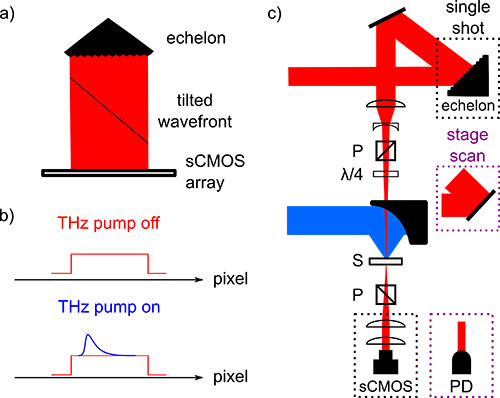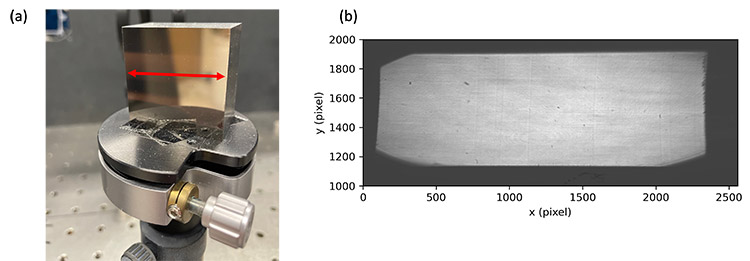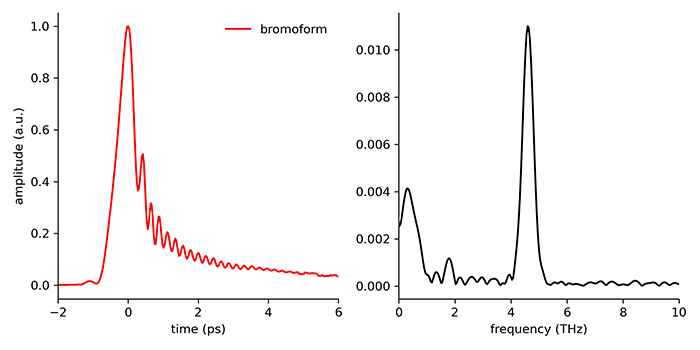Resources
 Part of the Oxford Instruments Group
Part of the Oxford Instruments Group
Expand
Collapse
 Part of the Oxford Instruments Group
Part of the Oxford Instruments Group
Spectroscopy in the terahertz frequency range (0.1-20 THz; 3-670 cm-1; 0.5-85 meV) has attracted significant interest in recent years, especially in condensed matter science[1]. In liquids, the elusive dynamics of hydrogen-bonding networks in water and alcohols can be directly probed with THz pulses. For bio-molecules, THz photons are resonant with long-range structural motions, such as protein backbone twisting modes, that are thought to be critical for enzymatic function. Further, a plethora of solid-state phenomena have prominent features at THz frequencies, including charge carrier dynamics, phonons, polaritons, magnons, and other quasi-particles. Finally, THz photons are sufficiently low in energy that they are non-damaging, non-ionizing, and non-heating to the sample. The wide range of sample capabilities and the unique properties of THz photons make THz spectroscopy a powerful contact-less characterization tool.
To investigate time-resolved dynamics of the aforementioned THz processes, which occur on ultrafast (femtosecond-to-picosecond; fs-to-ps) timescales, researchers have developed a number of linear and nonlinear ultrafast THz spectroscopic techniques with femtosecond time resolution. Ultrafast spectroscopy exploits laser pulses sufficiently short in time to study extremely fast electronic and nuclear dynamics that cannot be directly recorded by electronic digitization. Conventionally, ultrafast measurements are accomplished by precise control of the relative arrival time of the pump and probe pulses at the sample with a mechanical translation stage (delay stage) to alter relative optical path lengths.
By compiling a collection of sample responses at different pump-probe delay times, the time-resolved dynamics of the system can be determined. For frequency resolved ultrafast experiments in the optical and infrared (IR) frequencies, convenient spectrometers and heterodyne-detected 2D array detectors are available. However, these optical elements have yet to be developed for THz frequencies, necessitating the use of electro-optic (EO) sampling techniques, which also require scanning of an ultrafast time delay, to frequency-resolve the THz waveform.
While ultrafast spectroscopies provide unprecedented time-resolution, the use of mechanical translation stages significantly increases the acquisition time needed. In particular, for multidimensional spectroscopies, which require scanning of two or more time delays, experimental times can often be hours to days for stronger signals and impractical for weaker signals. As such, a number of multiplexed experimental setups have been developed over the years. In this application note, we discuss a single-shot detection scheme for ultrafast time-domain measurements using a reflective stair-step echelon and a sCMOS camera (ANDOR Zyla 5.5 MP)[2]. We detail our implementation in a nonlinear THz Kerr effect (TKE) spectrometer, which reduced acquisition time by approximately two-orders of magnitude compared to conventional stage-scan methods, and which also carries optical kerr effect (OKE) measurements in the same apparatus.
TKE spectroscopy measures the transient birefringence induced by intense THz pump pulses with weak near-IR probe pulses. It is a versatile technique and has been used to study orientation relaxation and vibrational dynamics in liquids, as well as coherent excitation of phonons, phonon-polaritons, and other quasi-particles in solids. Note that the echelon-based single-shot scheme described here is general and similar echelon-based schemes have been employed for linear THz spectroscopy[3], 2D THz spectroscopy[4], and other ultrafast optical spectroscopies[5].
The key idea of the echelon-based single-shot detection scheme is to create a "time-to-pixel" mapping such that each pixel position on the camera array represents a different pump-probe time delay, thus acquiring the entire time delayed signal in a single camera frame. This mapping is achieved by dispersing the probe pulse (800 nm) with a reflective stair-step echelon, which creates a tilted temporal wavefront in the probe beam due to the optical path length difference between adjacent steps. As a result, the probe photon arrival time at the sample varies linearly across the horizontal dimension of the beam (Figure 1a). By then imaging the surface of the echelon onto the sCMOS detector array, the time-delay signal can simply be read off the horizontal pixels of the camera, as shown in Figure 1b.
A schematic of our TKE spectrometer is shown in Figure 1c. Briefly, an off-axis parabolic (OAP) mirror is used to tightly focus the THz pulse to field strengths required for nonlinear spectroscopy. A Barlow lens system is used to focus the probe beam through a 3-mm hole on the OAP mirror. Both the THz pump and near-IR probe focuses are spatially overlapped at the front surface of the sample. The probe beam is then imaged by a horizontal and a vertical cylindrical lens to achieve the desired magnification in each dimension on the camera array.
The ANDOR Zyla camera is well suited for this application due to its fast frame rate with a global shutter, large well-depth, flexible binning, and excellent linearity across the full dynamic range. Using an appropriate region of interest (ROI) of the sCMOS array (80 pixels by 2560 pixels), we can achieve an externally triggered frame rate of 1 kHz on the Zyla camera, capturing every laser pulse out of the Legend Elite regenerative amplifier (1 kHz repetition rate).
To improve signal-to-noise, horizontal and vertical binning are used to transform the raw image into a 1280-by-1 array. Of note is that the excellent linearity of the Zyla camera prevents distortion of the nonlinear signal throughout data processing. The Zyla camera also enables a convenient method to image and optimize the THz focus and pump-probe overlap. A manuscript detailing this characterization tool is in preparation.

Figure 1: a) Schematic of the “time-to-pixel” mapping created by a micromachined Ni echelon. b) Raw signal from camera array with THz pump on or off. c) Imaging path for single-shot THz spectroscopy. P: polarizer; λ/4: quarter-wave plate; S: sample; CAM: camera; PD: photodiode. Blue beam: THz pulse; Red beam: 800 nm probe pulse.
The Ni echelon used in this note is CNC precision-machined [5] to have 1000-steps horizontally and is shown in Figure 2a. The 5 μm stair depth creates ∼ 33 fs of optical delay between adjacent steps and a total delay of 33 ps. Note that the stair width and depth can be tailored to enable various ultrafast time resolutions and total waveform windows. The resulting echelon image seen in Figure 2b is mapped onto ∼ 1000 pixels after binning. The exact pixel-to-time mapping is calibrated using a series of TKE signals, each with a known increase in probe optical delay (typically 1 ps apart) using a mechanical stage. This changes the horizontal pixel position that corresponds to temporal overlap of the pump and probe pulses (t = 0), effectively "sliding" the signal across the horizontal pixel axis. Using a cross-correlation procedure, the relative pixel-shift for 1 ps of time delay can be established accurately. Note that while the calibration procedure takes advantage of an optical delay line, no delay line movement occurs during single-shot data acquisition. The THz Nyquist bandwidth of the single-shot technique is limited by both the ultrafast pulse duration as well as the sharpness of the image, which is characterized by fitting edge spread functions (ESF) to the left and right edges of the echelon image.
The modulation transfer function (MTF), which can be calculated from the ESF, quantifies the spatial frequency dependent response of the echelon image in the horizontal direction. Due to the pixel-to-time mapping, there is a direct equivalence between spatial frequencies and THz frequencies, thus establishing an experimental Nyquist bandwidth of the single-shot scheme. Typical alignments in our laboratory result in Nyquist bandwidths of 8-10 THz.
Further experimental details, including extension to two-dimensional THz spectroscopy, can be found in our publications [4, 6].

Figure 2: (a) Mounted Ni echelon. (b) Image of the echelon surface on the sCMOS array.

Figure 3: (left) TKE spectra of liquid bromoform. (right) FFT of the vibrational coherence signal.
Figure 3 shows the TKE spectra of liquid bromoform (CH3Br) taken on our echelon-based single-shot TKE spectrometer. The signal is consists of three components: the instantaneous electronic response, the orientational decay, and the vibrational coherence. The instantaneous electronic response is due to the electronic polarizability of the molecule and follows the square of the THz electric field, which spans approximately 400 fs. Upon interaction with the linearly polarized THz pulse, bromoform molecules preferentially align to the THz polarization due to their permanent dipoles. The exponential decay component of the TKE signal is attributed to the relaxation of the anisotropic orientation distribution, which measures the orientation correlation timescale in liquids and is strongly linked to the bulk viscosity of the liquid. Finally, a clear damped oscillatory signal is observed, which corresponds to the coherent excitation of vibrational modes. The coherence signal can be isolated by fitting and subtracting the orientational decay. Figure 3 (right) shows the fast Fourier transform (FFT) of the isolated coherence signal, which shows a clear peak at 4.6 THz, corresponding to the intramolecular vibrational mode ν6 of bromoform.
Ultrafast THz spectroscopy is a previously under-explored technique that can provide unique insights into the dynamics of numerous processes in liquids and solids. The echelon-based single-shot technique described here is extremely versatile and has been implemented to significantly reduce the acquisition time of several time-resolved THz spectroscopies, including THz-TDS, nonlinear TKE spectroscopy, and two-dimensional THz spectroscopy [2, 4, 7, 8]. We detail our implementation in nonlinear TKE spectroscopy using a 30-ps echelon and a 1 kHz fast frame rate sCMOS camera (ANDOR Zyla 5.5 MP). Approximately two-orders of magnitude reduction in acquisition time is achieved, which brought measurement times of two-dimensional THz spectra from several hours to less than one hour [4].
[1] J. Axel Zeitler, Kai-Erik Peiponen, and Makoto Kuwata-Gonokami. Terahertz Spectroscopy and Imaging. Ed. by Kai-Erik Peiponen, Axel Zeitler, and Makoto Kuwata-Gonokami. Vol. 171. Springer Series in Optical Sciences 2. Berlin, Heidelberg: Springer Berlin Heidelberg, 2013, pp. 344–354. arXiv: arXiv:1011.1669v3.
[2] Griffin Mead et al. “An echelon-based single shot optical and terahertz Kerr effect spectrometer”. In: Review of Scientific Instruments 90.5 (May 2019), p. 053107.
[3] Yasuo Minami et al. “Single-shot measurement of a terahertz electric-field waveform using a reflective echelon mirror”. In: Applied Physics Letters 103.5 (2013).
[4] Griffin Mead et al. “Sum-Frequency Signals in 2D-Terahertz-Terahertz- Raman Spectroscopy”. In: Journal of Physical Chemistry B 124.40 (2020), pp. 8904–8908. arXiv: 2007.08694.
[5] T. Kuribayashi et al. “Anharmonic phonon-polariton dynamics in ferroelectric LiNbO3 studied with single-shot pump-probe imaging spectroscopy”. In: Journal of Applied Physics 123.17 (2018).
[6] Haw-Wei Lin, Griffin Mead, and Geoffrey A. Blake. “ Mapping LiNbO 3 Phonon-Polariton Nonlinearities with 2D THz-THz-Raman Spectroscopy ”. In: Physical Review Letters 129.20 (2022), p. 207401.
[7] Marta Duchi et al. “2D-Raman-THz spectroscopy with single-shot THz detection”. In: Journal of Chemical Physics 155.17 (2021).
[8] Frank Y. Gao et al. “High-speed two-dimensional terahertz spectroscopy with echelon-based shot-to-shot balanced detection”. In: Optics Letters 47.14 (2022), p. 3479.
Material on Single-shot Detection for Ultrafast Linear and Nonlinear Terahertz Spectroscopy with Andor's Zyla
[1] Zhang, Z., Gao, F.Y., Chien, YC. et al. Terahertz-field-driven magnon upconversion in an antiferromagnet. Nat. Phys. (2024). https://doi.org/10.1038/s41567-023-02350-7
[2] Zhang, Z., Gao, F.Y., Curtis, J.B. et al. Terahertz field-induced nonlinear coupling of two magnon modes in an antiferromagnet. Nat. Phys. (2024). https://doi.org/10.1038/s41567-024-02386-3
[3] Frank Y. Gao et al., Snapshots of a light-induced metastable hidden phase driven by the collapse of charge order Sci.Adv.8,eabp9076(2022).DOI:10.1126/sciadv.abp9076
Date: April 2023
Author: Haw-Wei Lin, Geoffrey A. Blake (Caltech)
Category: Application Note
